When I want bread to accompany dinner, this Italian bread recipe is what I pull out, almost without fail. The inside is soft and chewy; the crust, delightful. It's easy-to-make, and equally importantly, delicious!
Good homemade bread will turn you into a bread lover. I generally don't eat complimentary bread at restaurants, but at home, I will eat more of the loaf than a reasonable person should.
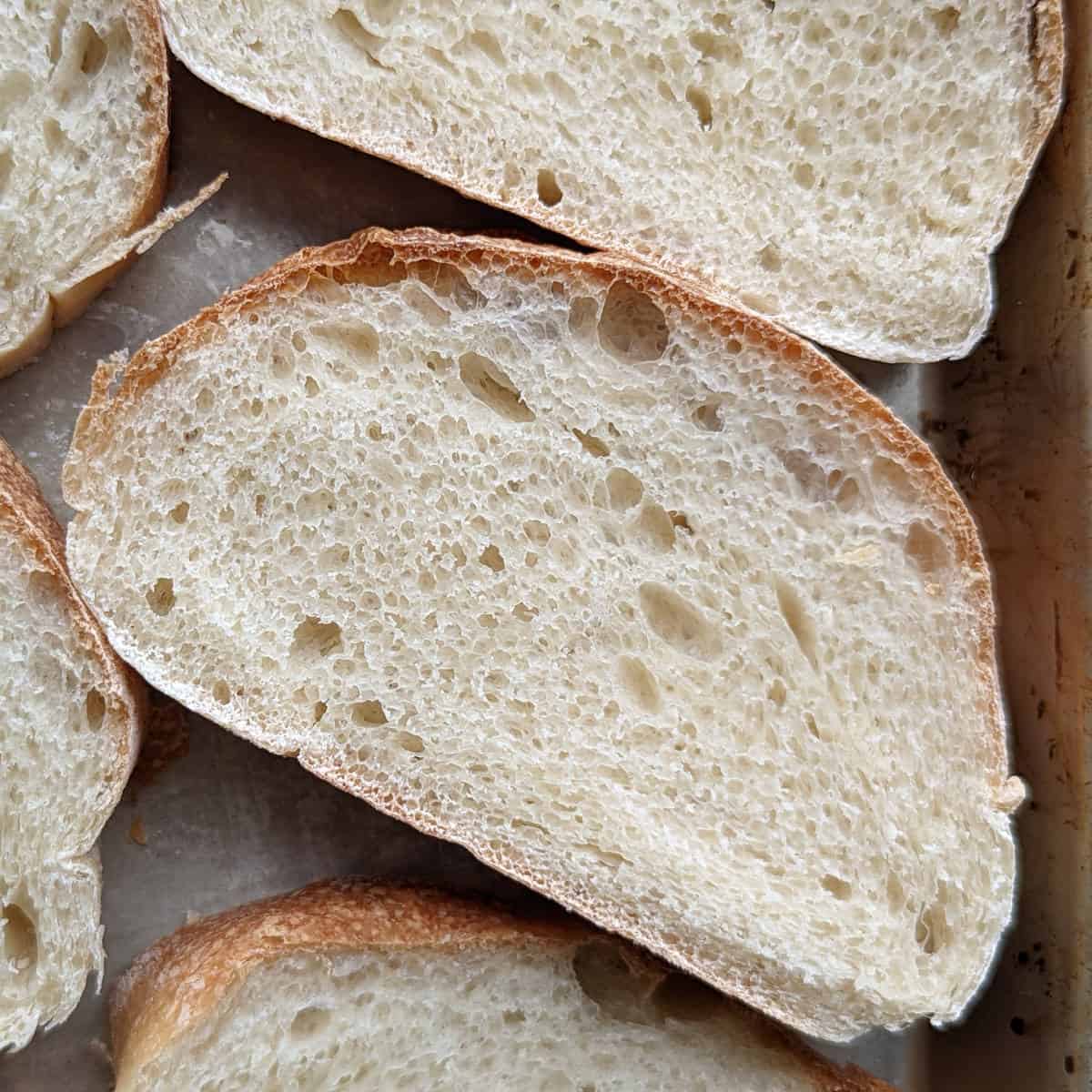
I make this bread often. It's what I usually make each year to turn into garlic bread alongside our Christmas lasagna. Its flavor is vastly superior to anything you could buy at a grocery store.
Jump to:
[This post contains affiliate links. I may make a commission for purchases made through links on this post.]
What is Italian Bread?
There's lots of different types of Italian breads - ciabatta, focaccia, pizza, to name a few. What we in the US consider to be Italian bread really isn't any of those.
The Italian bread I make here closely resembles like French bread, but a bit softer with the inclusion of a small amount of sugar and olive oil. Whereas my Easy French Bread makes narrower and longer crusty baguettes, Italian bread loaves are wider and squatter.
I first wrote about this specific bread recipe in 2012 and reprised it for my year of bread in 2014. There are lots of recipes for Italian Bread, but mine comes from Peter Reinhart's The Bread Baker's Apprentice (affiliate link), which basically taught me how to make bread.
Why do I have to start the dough the day before I bake it?
You start this bread the day before you want to bake it. You start by making a pre-ferment, which feature in a lot of the recipes from The Bread Baker's Apprentice (affiliate link); this dough rests overnight to develop great flavor to add to your bread. It sounds cumbersome, but it's not; it only takes a little planning.
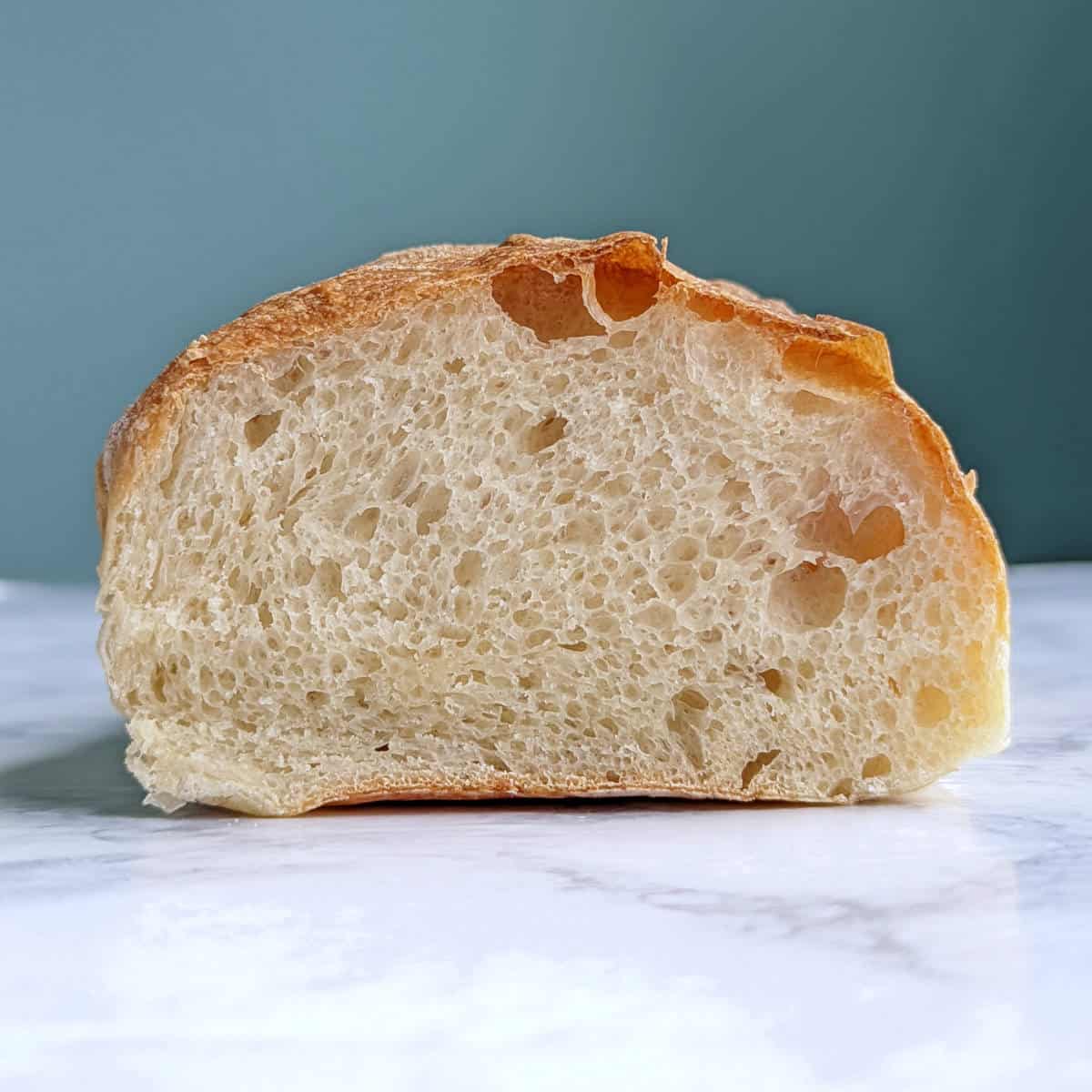
That said, if you wake up wanting homemade bread at dinnertime, you can start your bread first thing in the morning and bake it in the afternoon. It will still be delicious and better than a grocery store loaf; it just won't have reached its full potential.
How to Make Italian Bread
I used bread flour for this because it has more protein and develops more gluten, resulting in a chewier loaf. You can use all-purpose flour instead, and sometimes I do; it will still be better than grocery store bread.
You can make this bread using a stand mixer, or by hand. I've done both. I prefer the stand mixer because it kneads things faster than I can, but I do it by hand when I visit my parents.
On the evening before, mix together all of your ingredients for your first dough (or biga). Knead it with your hands or with a stand mixer. It should become tacky and stretchy, but not sticky. Although honestly, if you don't knead it very much at this point, it's not a huge deal. Let it rise a bit in a warm place, then refrigerate overnight.

The next morning, take your dough from the fridge about an hour before you want to mix together your dough, to take the chill off. The dough will have doubled in size, even in the refrigerator.
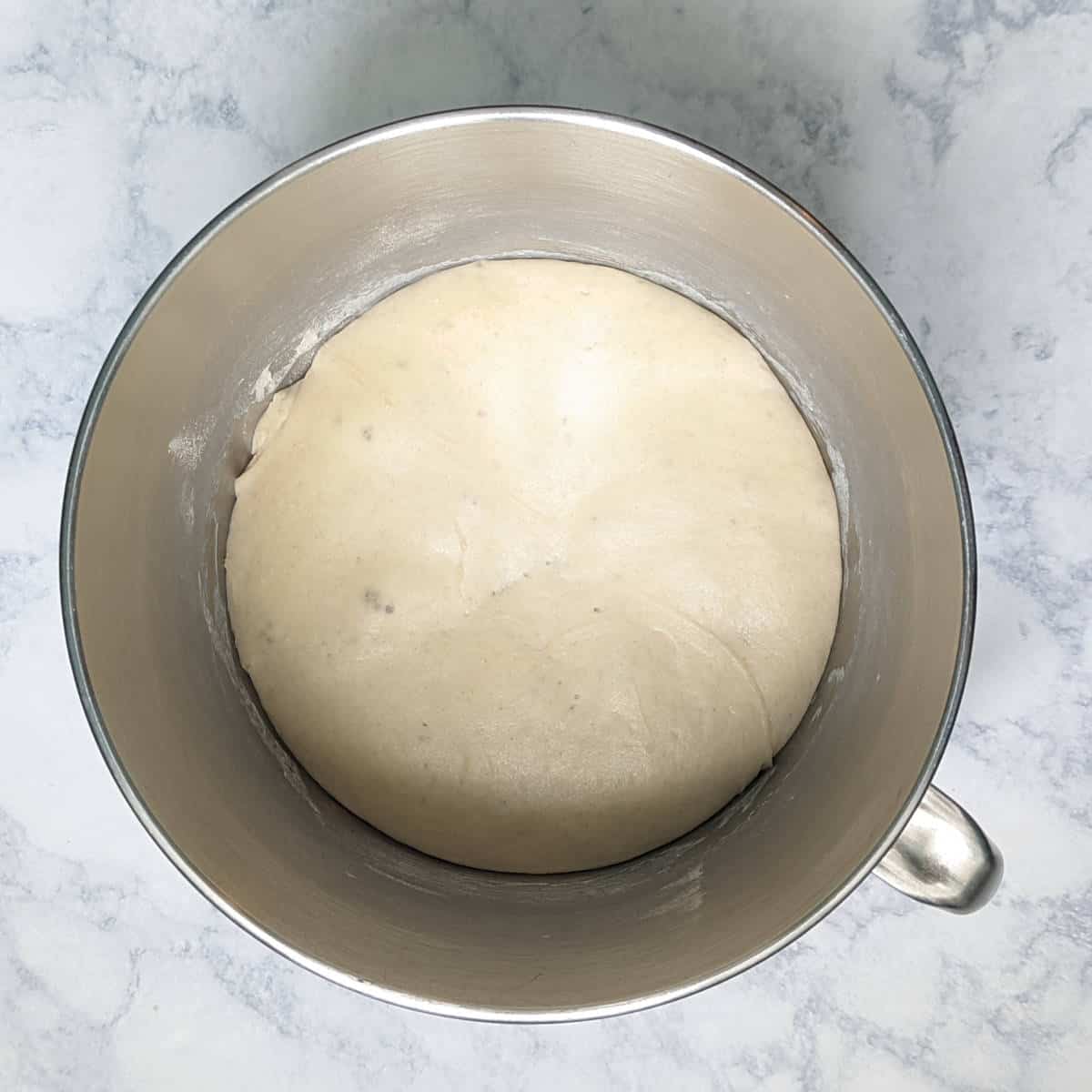
Cut your dough into about 10 pieces before mixing with the rest of the ingredients. This is especially important if you are mixing and kneading by hand, as it makes it much easier to mix thoroughly.
Mix together all of your ingredients, either by hand or in a stand mixer. Your dough should be soft and sticky at this point - a lot of dough sticks to your fingers when you touch it. It's ok if it's very sticky; you can incorporate more flour as you knead the dough. It's harder to add water to the dough later on if it's too stiff.
Knead the dough for about 10 minutes, either by hand on in the stand mixer on medium-low speed. However, how long you knead is much less important than how the dough feels.
You want the dough to be tacky and soft, but not sticky. Tacky dough sticks like a Post-It note; it clings to your finger, but leaves little-to-no residue behind.
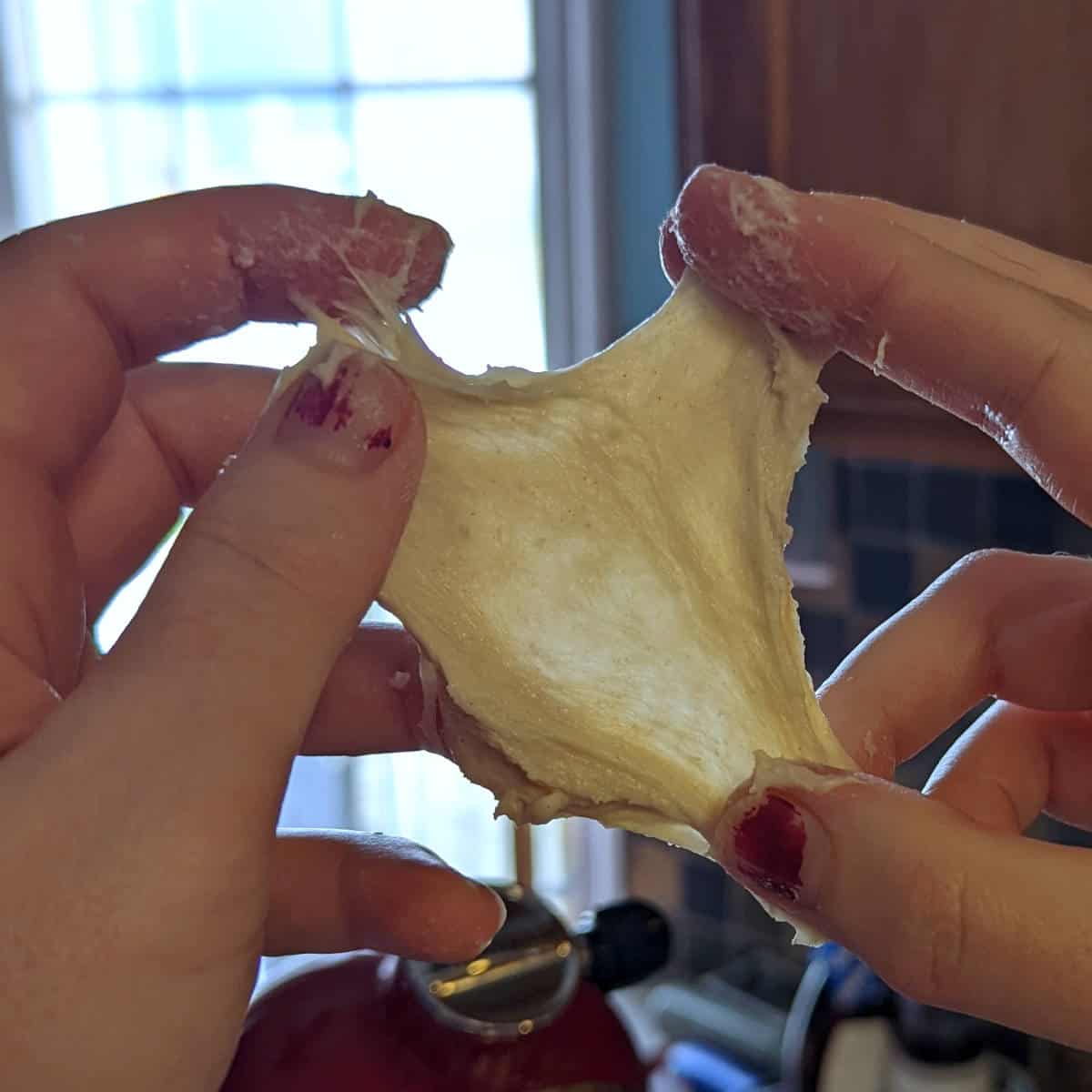
The dough should also pass the windowpane test. Pinch off a small amount of dough and flatten it out between your fingers. You should be able to stretch it without tearing it. If you hold it up to the light, you should be able to see the light behind it.
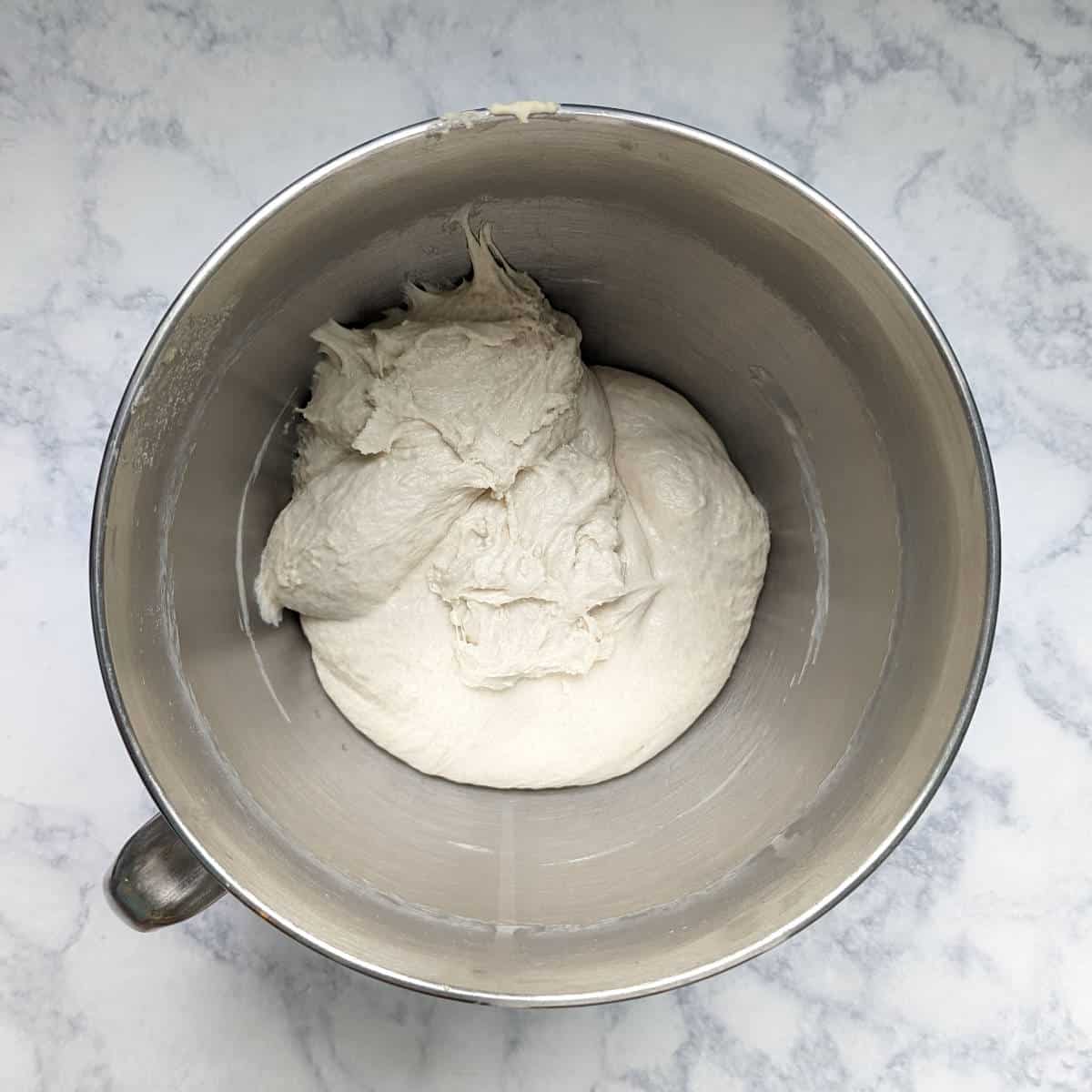
Place your dough in an oiled bowl. I usually reuse the stand mixer bowl. Spray the top of the dough with oil, cover with plastic wrap, and let rise for 2 hours, until doubled in size.
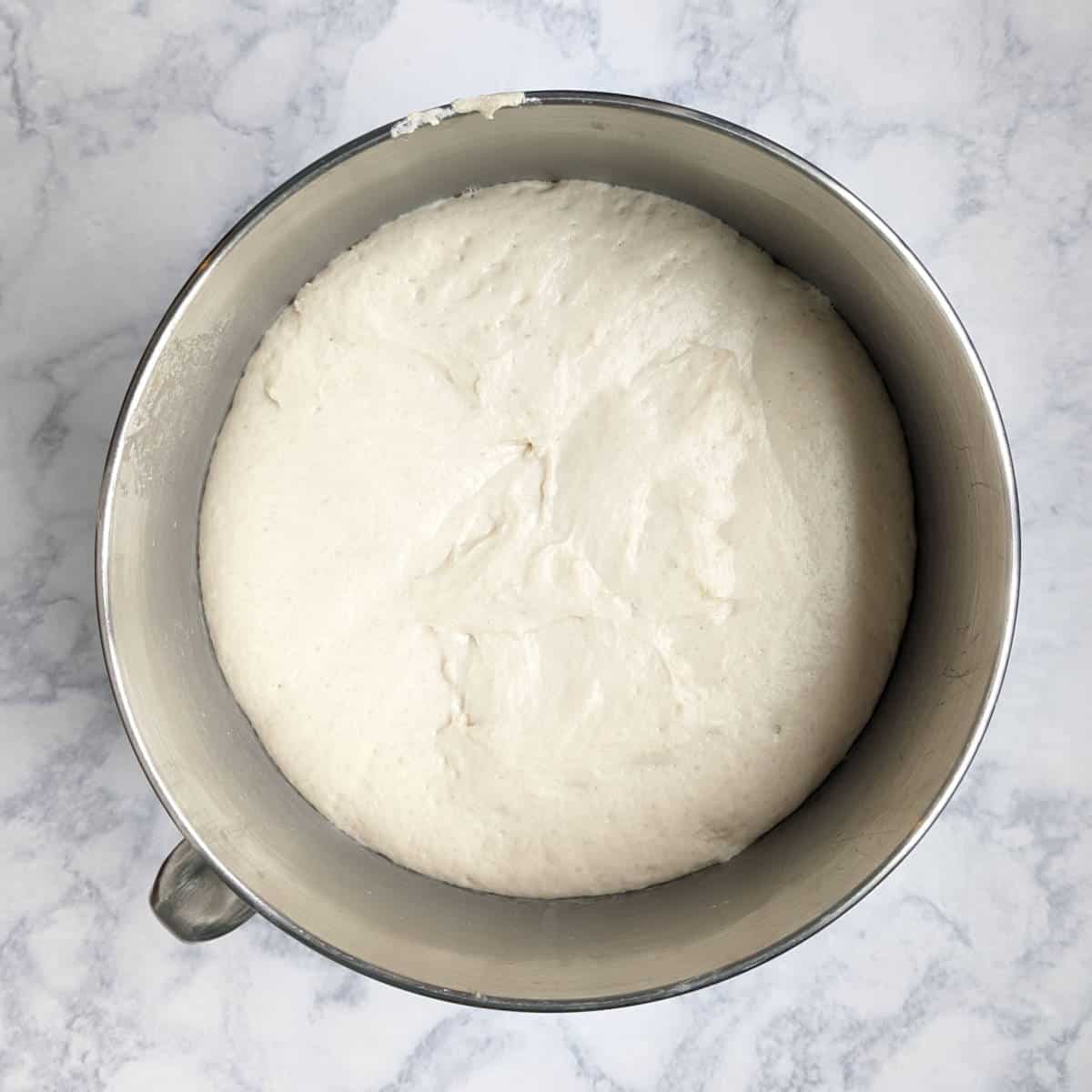
Cold kitchen? Here's my trick. I preheat my oven for exactly 2 minutes. Then I turn off my oven and place my dough inside. The oven isn't too hot yet, so it rises nicely.
Divide your doubled dough into two halves, being careful not to deflate the dough too much. Flatten each ball of dough into a disc, then pat into a tall rectangle.
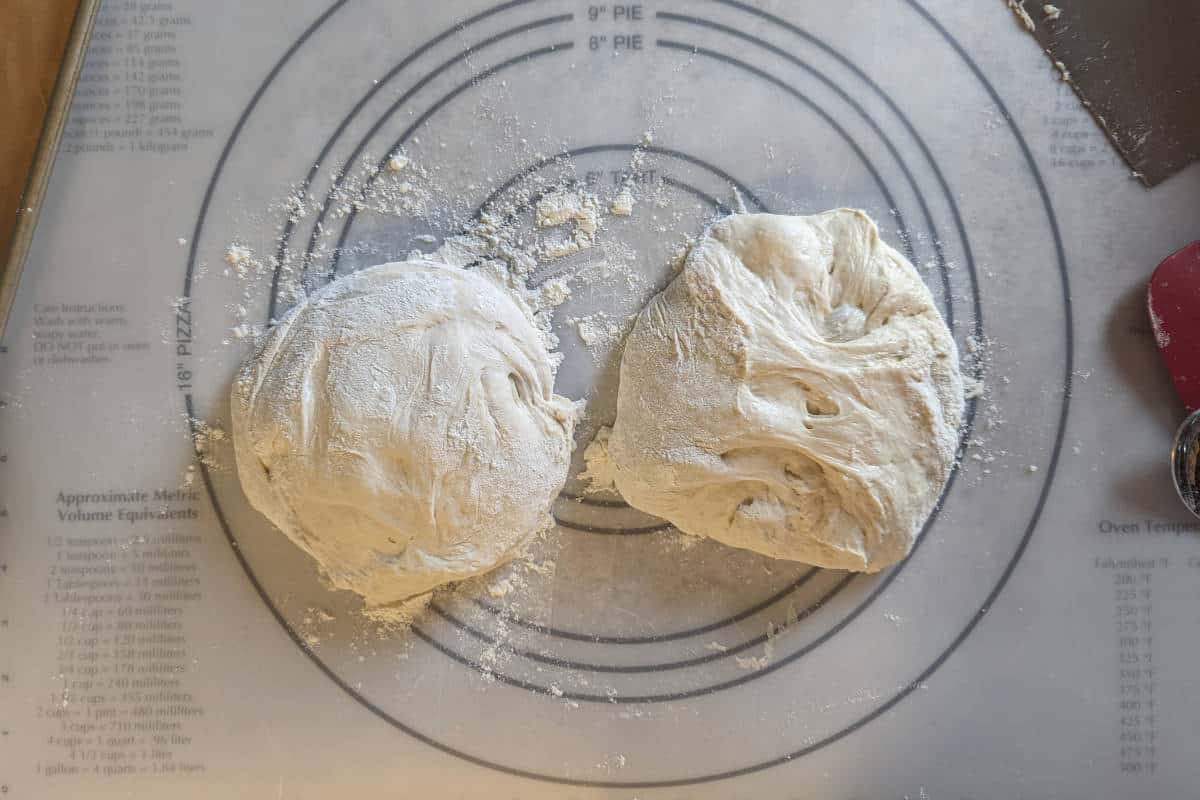
To shape: fold the top third of the dough over the middle third, like you would fold a paper or letter over. Next, fold the bottom third up over that seam, and seal the edge to the top edge of the dough.
Repeat with the other round of dough. You will have two rough, squat loaves. Roll and stretch each one out until it's roughly 12 inches in length.
Dust a sheet pan with a little semolina or cornmeal, then place the loaves on it. Spray the tops of each loaf with cooking spray, then cover with plastic wrap. Let rise until the loaves are about 1 ½ times their original size, about an hour.
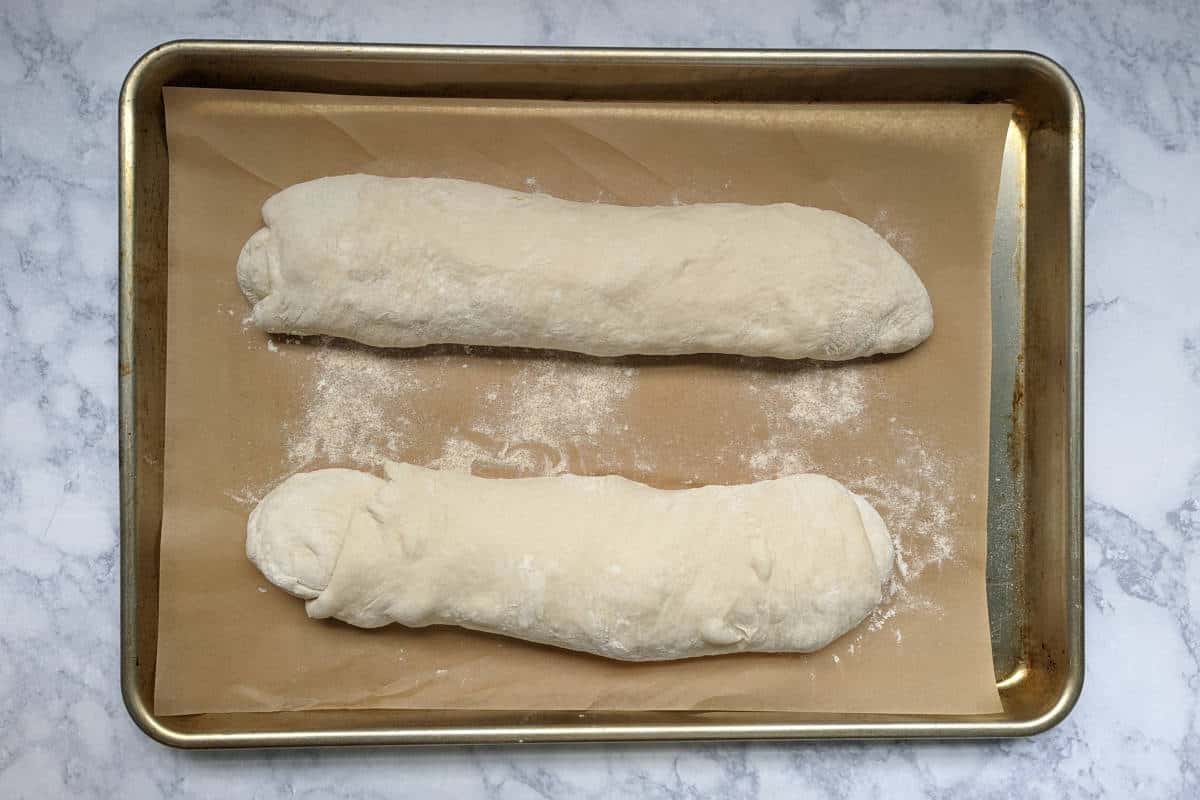
Check on your loaves 30 minutes into their rise, and place an empty metal baking pan on your bottom oven rack so it can warm with your oven. Start preheating your oven to 475F or 500F. (If your oven makes your smoke detector go off at 500F, by all means, choose 475F or even 450F!)
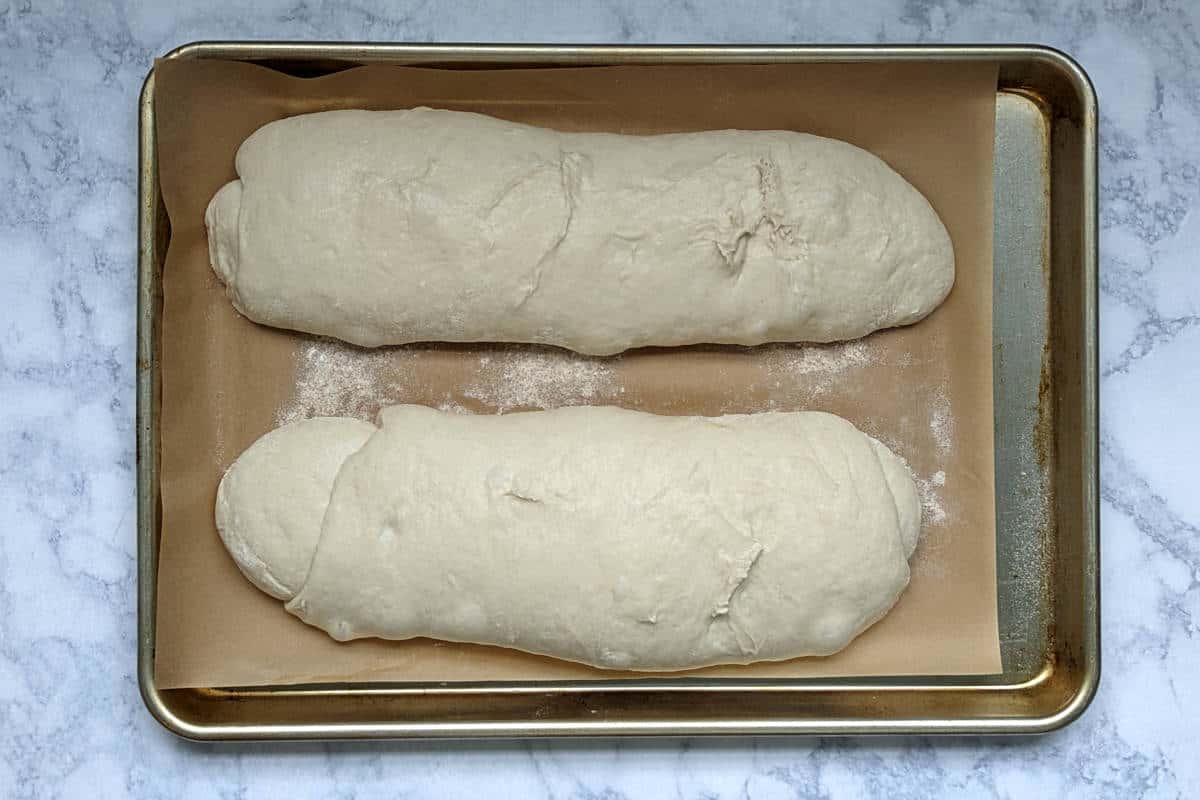
Make one vertical or a couple of diagonal slashes on your bread dough before you place them in the oven. This allows steam to come out of the dough and lets the crumb open up a bit. You need a rather sharp knife for this.
Place the baking sheet in the oven. Wearing an oven mitt, carefully pour 1 cup of hot water into the hot pan on the bottom rack to create steam that will help give your bread a nice crust.
Reduce the oven temperature to 450F. Bake the loaves for about 20 minutes, rotating halfway through if necessary. The bread will be golden brown when done, and if you tap on the bottom of a loaf, it will sound hollow.
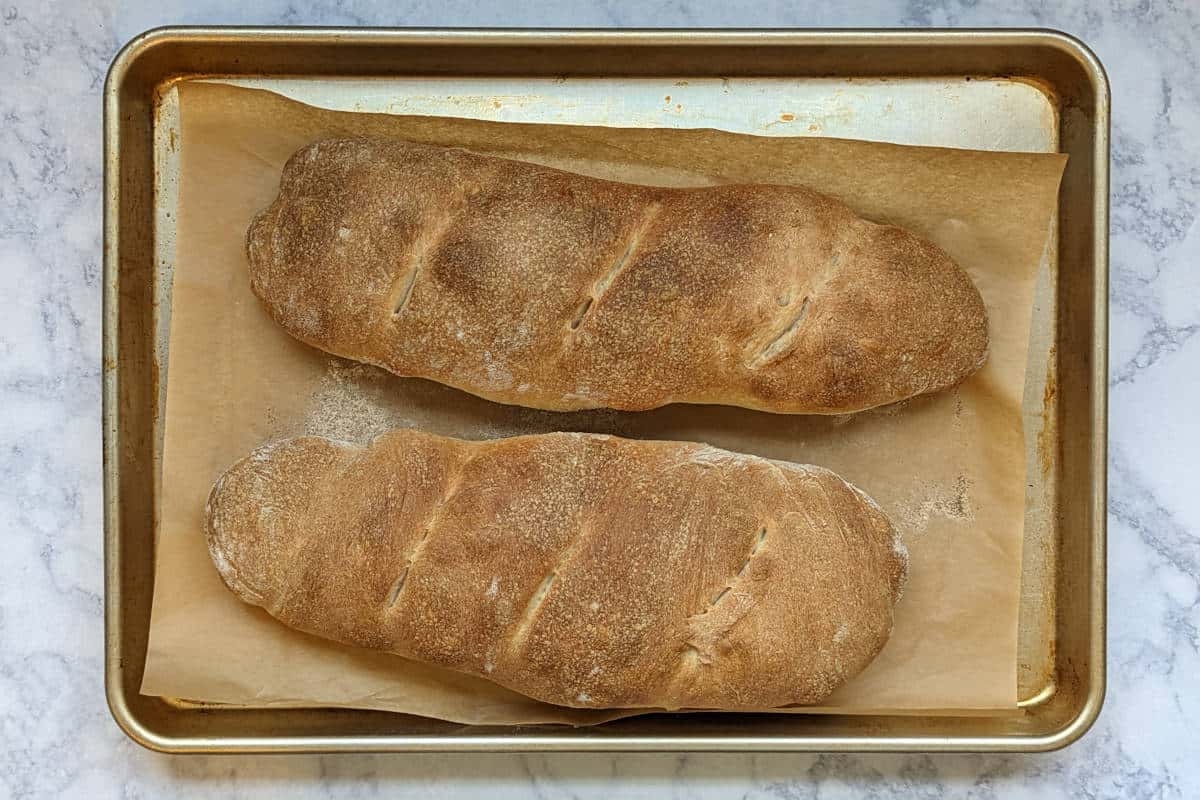
Allow bread to cool briefly, then transfer to a wire rack to cool completely, or at least an hour, before cutting.
How to Serve Italian Bread
To cut bread well, use a large serrated bread knife (affiliate link) and a sawing motion. With other knives, you run the risk of tearing or smashing the bread. I usually just cut off what we are going to eat at that meal, and leave the rest as a loaf. Sliced bread dries out more quickly.
On the day I bake this, I make a meal of fresh bread dipped in good olive oil with a little salt and pepper. I have a few baby carrots or other vegetables on the side, for balance.
We eat the bread fresh and unadorned alongside soups or other light meals. On the second or third day, I turn it into garlic bread. My husband and daughter turn it into some nice grilled cheese sandwiches, or just eat a slice with jam or almond butter for breakfast.
Clearly, you can't go wrong with how you serve this bread. It's versatile!
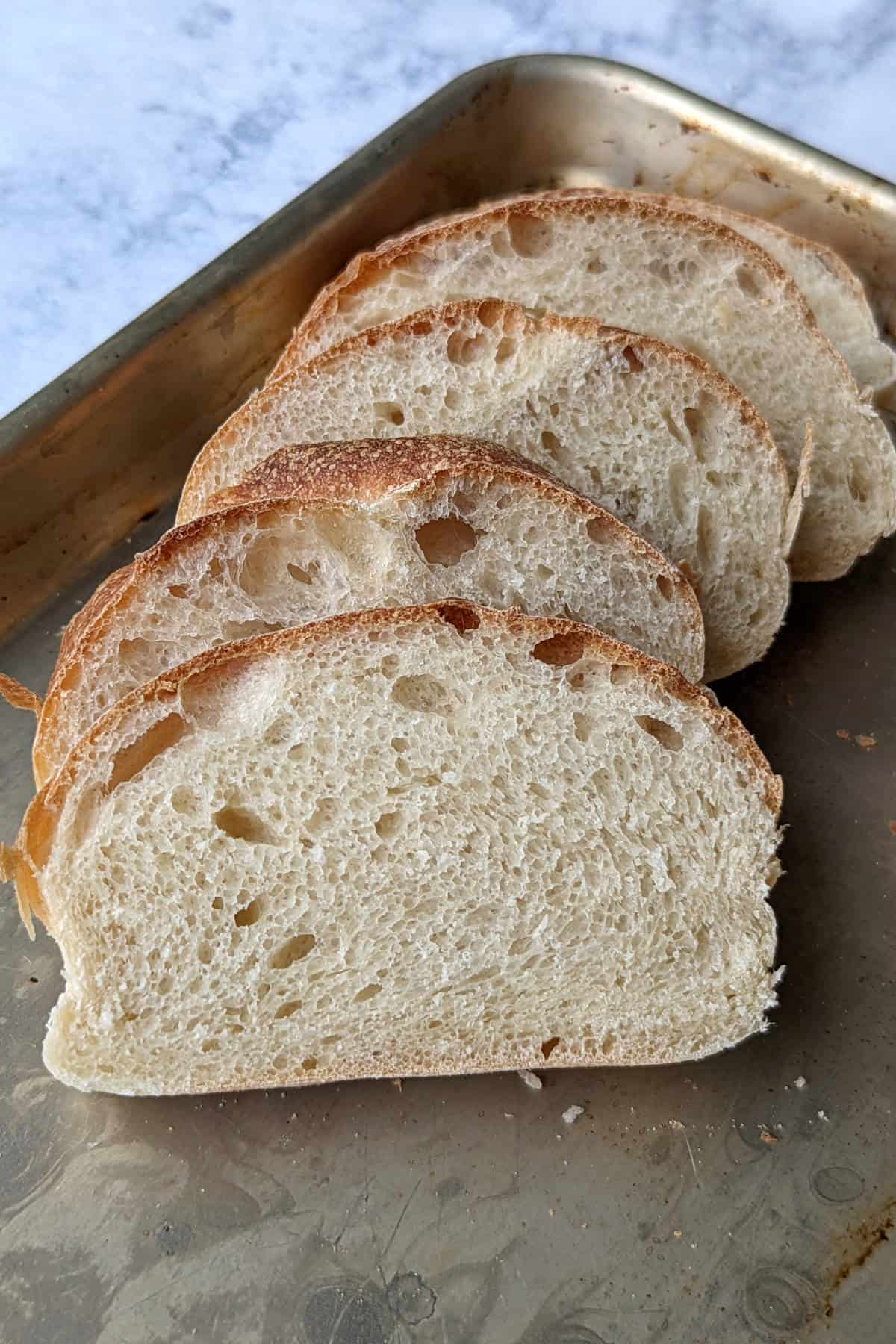
Storing
Store the bread in an airtight container at room temperature. Bread will go stale more quickly in the refrigerator. I have a bread box (affiliate link) that I bought specifically to easily store bread. It usually lasts 4-5 days, although how long it lasts also depends on heat and humidity. It will grow moldy in warmer, humid weather.
Luckily, Italian bread freezes well! You can freeze the bread uncut or in slices. Cut a loaf in half. If desired, slice it, but keep the slices together. Wrap your partial loaf or bundle of slices in a layer of aluminum foil, followed by 1-2 layers of plastic wrap. Store in a freezer bag. The bread will last at least a month in the freezer.
Unwrap and thaw at room temperature. Fan out the slices as soon as they aren't stuck together; this helps them thaw faster. Thaw for at least an hour, although an uncut partial loaf may take longer. Enjoy your homemade bread with your meal!
Interested in other recipes? I save and share recipes I like or want to try on my Pinterest page - follow me there! You can also check out my Facebook page for more recipes and helpful tips. I'm also happy to try to help troubleshoot my recipes there.
Have you tried this recipe? Or have a question about it? Rate it or leave a comment below! (PS: rating my recipes helps other people find them, too!)
Delicious meals to go with Italian Bread:
Other fantastic breads:
📖 Recipe
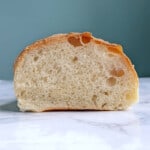
Italian bread is similar to French bread, but is wider and softer. This bread is perfect for dipping in oil, as well as for making sandwiches and garlic bread!
- 2 ½ cups bread flour (11.25 ounces)
- ½ teaspoon yeast (.06 ounces)
- ⅞ cup water (7.5 ounces; ¾ cup + 2 tablespoons)
- 2 ½ cups bread flour (11.25 ounces)
- 1 ⅔ teaspoons table salt (.41 ounces)
- 1 tablespoon sugar (.5 ounces)
- 1 teaspoon yeast (.11 ounces)
- 1 tablespoon olive oil (.5 ounces)
- ¾ cup water (7 ounces)
-
In a large bowl or stand mixer, mix together the flour and yeast. Stir in the water and make a dough that's neither too stiff nor too sticky. Add a little more flour or water as necessary.
-
Once the dough comes together, knead on a lightly floured surface, or in your stand mixer on medium-low, for about 6 minutes, until the dough is soft and pliable. The dough should be tacky - it wants to hold on to your finger like a Post-It note does, but doesn't really leave any dough behind.
-
Place dough in a lightly oiled bowl, coat dough with oil, and cover with plastic wrap. Let rise for 2-4 hours, until doubled in size. Degas the dough, return it to the bowl, cover, and refrigerate overnight.
-
Remove the cold dough from the refrigerator 1 hour before making the dough. Cut it into about 10 pieces (to make mixing easier). Let sit, covered, at room temperature for 1 hour to take off the chill.
-
In a stand mixer or large bowl, mix together the Day 1 dough, flour, salt, sugar, yeast, olive oil, and ¾ cup water, and mix until a ball forms. Your dough should be slightly sticky and soft; add a tiny bit more flour or water if necessary. You'd rather your dough be too sticky now, as it's hard to add water to dough later.
-
Knead dough with your stand mixer on medium speed, or on a floured surface, for about 6-10 minutes. (Kneading by hand will take longer.) Your dough should be soft and tacky, like a Post-It note that clings to you, but not sticky. It will also pass the windowpane test; see notes below.
-
Place kneaded dough in an oiled bowl, coat with oil, and cover with plastic wrap. Let rise at room temperature for about 2 hours or until dough doubles in size. If your kitchen is cold, see notes for tips on making a warm space to have your dough rise.
-
Gently divide the dough in half, deflating the dough as little as possible. (That said, I degassed my dough a lot, and it didn't harm it at all.) Flatten out each ball of dough into a tall rectangle.
-
Fold the top third of the dough over the middle third, like you would fold a paper or letter over. Next, fold the bottom third up over that seam, and seal the edge to the top edge of the dough. Repeat for the other rectangle. You will have 2 rough, squat loaves.
-
Let the dough rest for 5 minutes to let the gluten recover, if necessary. Stretch and roll the loaves out to about 12 inches in length. Place each loaf on a baking sheet lined with parchment or dusted with cornmeal or flour.
-
Spray the top of each loaf with oil, cover with plastic wrap, and let rise for about an hour, or until loaves have grown to about 1 ½ times their original size.
-
Preheat oven to 475-500F, and place an empty pan on the bottom rack of the oven (so it can preheat to turn water into make steam). Heat some water, preferably in a kettle, so you can pour it into this pan later.
-
When the oven is preheated, score the bread with a sharp knife. Place the baking sheet on the middle oven rack. Using a gloved hand, carefully pour the water into the hot pan on the bottom oven rack. Be careful not to create spatters that may crack your oven door's glass. Close everything back into the oven.
-
Lower the oven temperature to 450F. Bake the bread for about 20 minutes, rotating halfway through the baking time if necessary. The bread will be golden brown when it's done. It will sound hollow if you tap on the bottom; it will be 200F if you take its temperature with a thermometer.
-
Transfer loaves to a wire cooling rack as soon as possible. Cool at least 1 hour, but preferably 2, before cutting.
Forget to start your bread dough the night before? Start the Day 1 dough first thing in the morning, letting it rise 2 hours before combining it with the remaining dough ingredients.
Bread flour works best for making stretchy bread like this. However, it works fine with all-purpose flour; your bread will simply be a little less chewy.
Dough will absorb additional flour as you knead, so err on your dough starting off too wet, rather than too dry.
Windowpane test: take a small piece of dough and stretch it out between your fingers. It should stretch out a large amount without tearing. It should also become thin enough that you can see light behind the dough.
To make a warm proofing space in a cold kitchen, I preheat my oven for 1-2 minutes, then turn off the heat. I close the bowl of dough in the oven. This is warm enough to prove the dough, but not too hot. However, your oven may heat more or less quickly than mine does.
Adapted from Peter Reinhart's The Bread Baker's Apprentice (affiliate link)
In the past:
[Originally posted January 1, 2012. Completely redone in March 2022.]

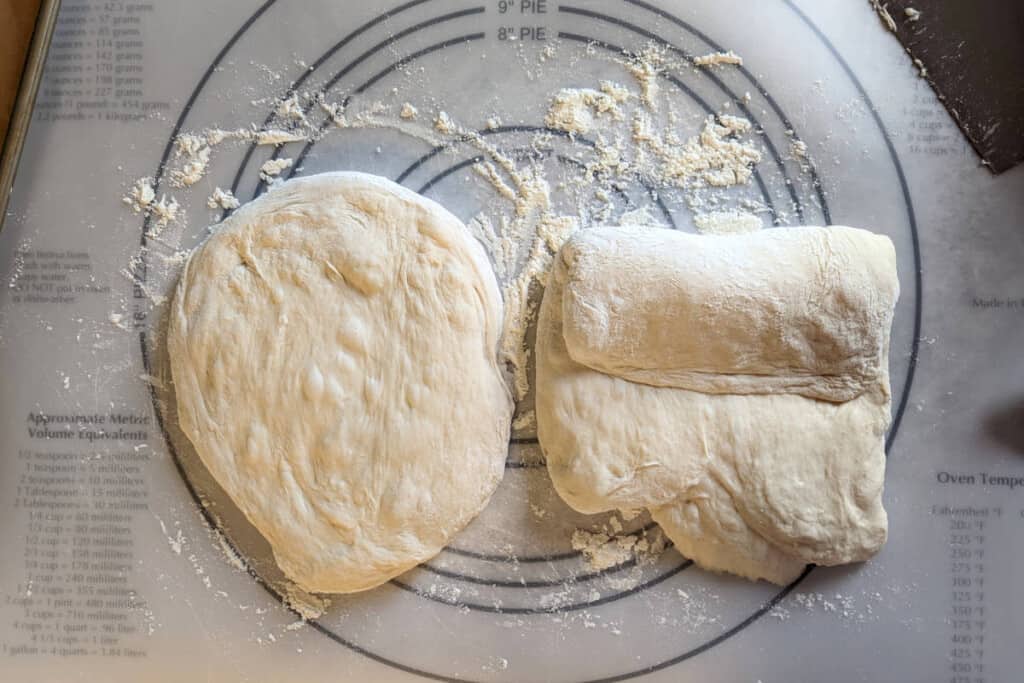
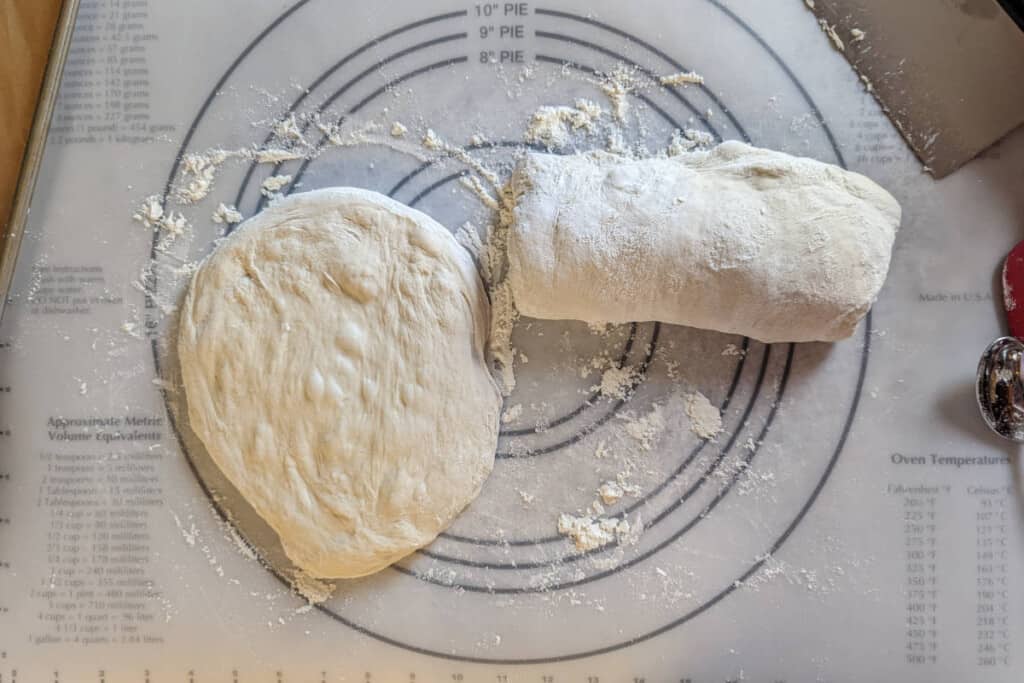
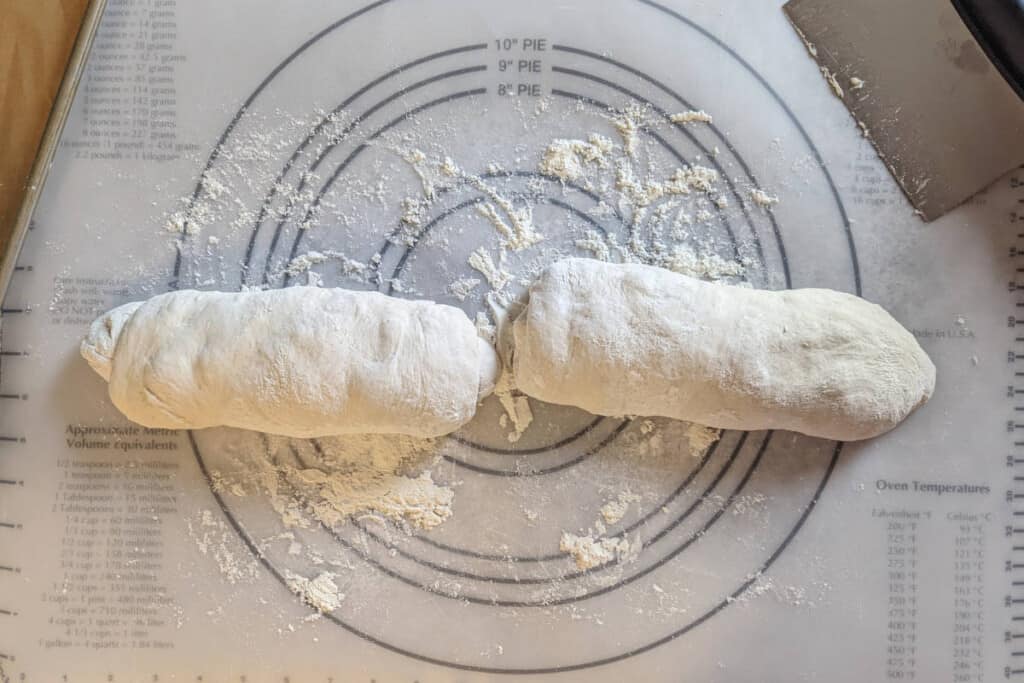

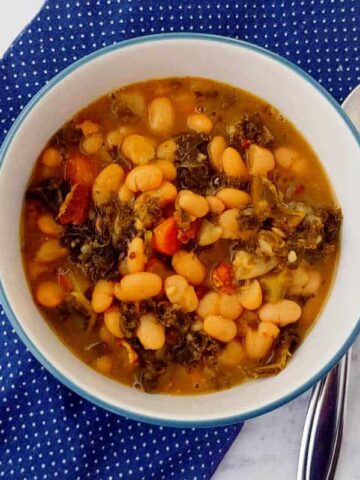


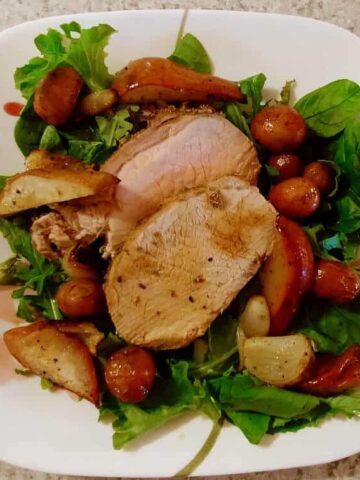
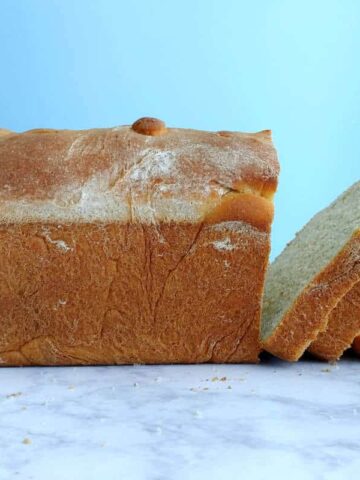
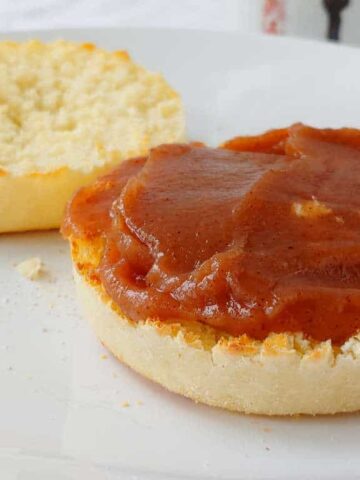
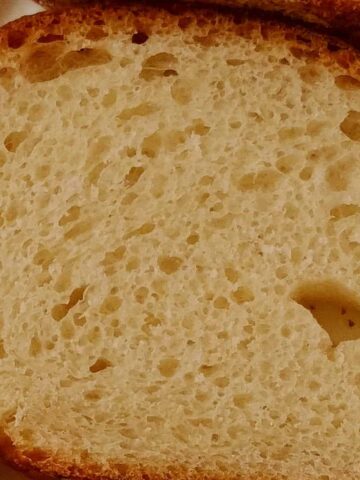

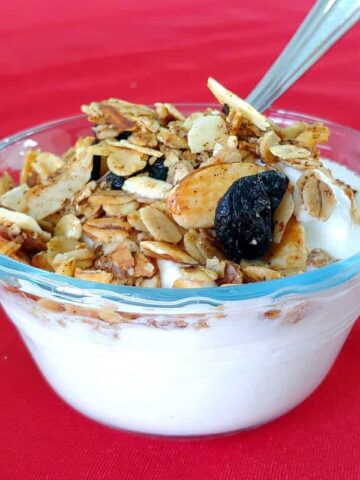





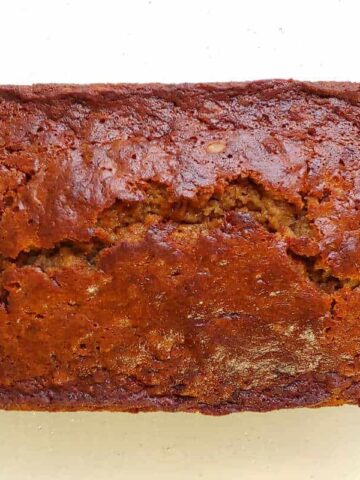



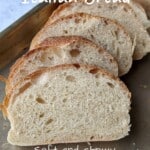
Leave a Reply